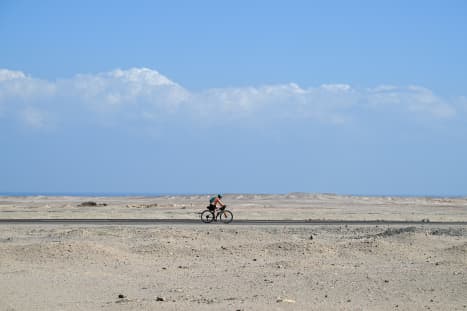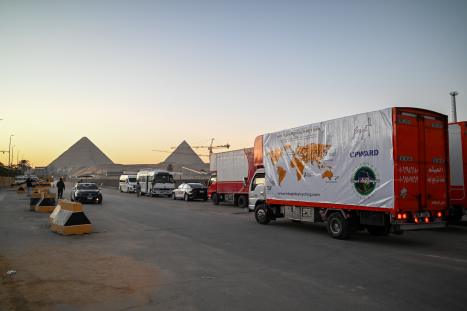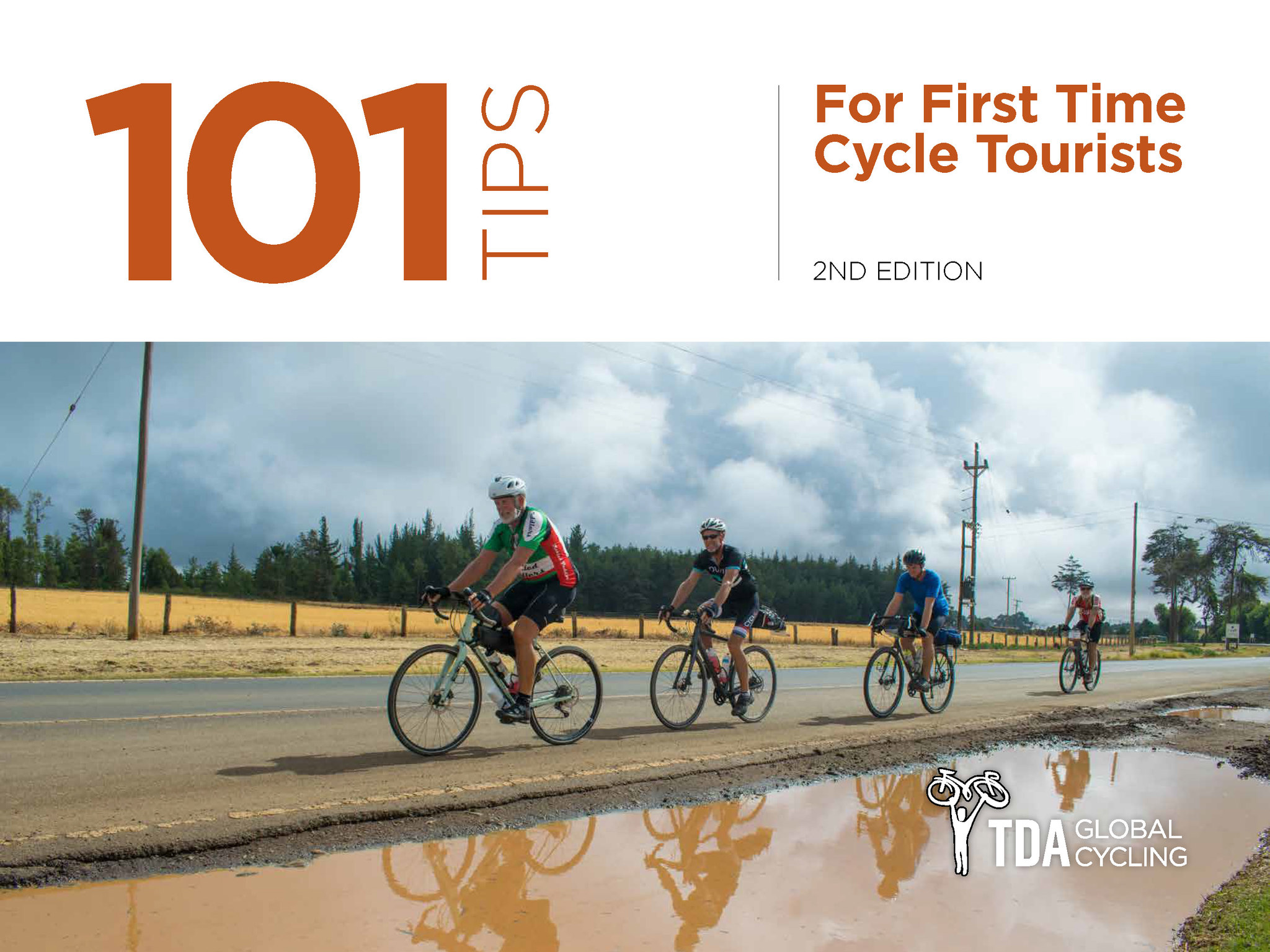Blog
How To Choose A Bike For The Tour d’Afrique Cycling Expedition
Benjamin Levin is the Content Creator on the 2024 Tour d’Afrique Cycling Expedition. In this report, he looks at some of the bikes being used on this year’s ride.
What is the most important thing that you can bring on a bike tour across Africa? Well, a bike of course. Simple, right? In a way yes, but it is also a huge decision that will potentially impact four months of your life if you are riding the entire Tour d’Afrique from Cairo to Cape Town.
Do you want a carbon fibre bike, light on the road but potentially fragile? Maybe, maybe not. Do you want a steel tank of a bike that destroys the gravel sections but is a bit more difficult to climb the base of Kilimanjaro with? Maybe, maybe not. The truth is there is not one bike that answers all the demands of this long, challenging journey. A lot simply depends on what you are comfortable with. We asked some of the riders about the bikes they are currently using on the 2024 Tour d’Afrique so they could inform future riders of the pros and cons and the nitty gritty details of their bikes.
Jim Flynn (Australia)

Jim is riding a Curve bike. It is a full titanium frame that is set up for long distance riding and endurance cycling, particularly off road. Jim likes the titanium frame because of the flexibility that it provides along with the strength. The bike has been modified by adding aerodynamic extension bars to the handlebars. “Probably the most important thing I have got, which is essential for long rides like this, is the extension bars.” He says that having another hand position gives him a lot of relief on long rides. “I would spend all my time on those bars if I could.” Jim explains how people can get neuropathy from using the same generic grip every single riding day and that the options that his extension bar provides are very helpful.
He also has a suspended headset which gives him a bit of deflection which he appreciates on the dirt and gravel. Another thing Jim talks about is his choice to opt for a mechanical one by twelve gearing set up for simplicity. Though he has ridden with electronic gearing in the past, with different set ups, he says when cycling through Africa he prefers to keep things simple, and importantly, parts source-able. It can be difficult to find more modern/complex bike parts in many parts of Africa so keeping things basic is a sensible way to go.
What Jim recommends: Try to have a system that allows you to have multiple hand holds. Also, unrelated to biking but still very important, come with an open attitude and a love of adventure he says. “I think you have got to have a bit of a love of adventure and be prepared to put yourself out a little bit!”
Justene Wilkes (United States)

Justene is riding a Surly Bridge Club that she purchased specifically for this trip. She says that in the past she has ridden an aluminum road bike with a carbon fork but for this trip she wanted something that could handle a wider range of terrain and climbs. Her Surly Bridge Club is all steel and sized up so it is more robust. She loves the steel but says it is heavy and it makes some of the climbing days that much more challenging. However, on the dirt, this bike is a rock star. “We recently had a day of 55 kilometres of rock and dirt and I just plowed right through it… I attribute that to the steel bike and the wide tires that it came with,” she says proudly.
Justine explained that she did not exactly know what to look for when buying a bike for this tour so sensibly she went to her local bike shop to get some recommendations and this was one of the bikes they recommended for her. “One feature that I quite liked is the single chainring in the front, one less thing to break and go wrong for me, and so far I have been very happy with that choice, but the downside is that when we have a really wicked tail wind, I sometimes cannot keep up because I have a max speed I can do.”
What Justine recommends: Carry snacks and Tylenol!
Helen Smith (United Kingdom)

Helen is riding a Hardtail mountain bike, a specialized rockhopper. “I decided to ride the Tour d’Afrique on this bike mainly because I absolutely love riding it!” Helen explains that with the combo of off-road and tarmac, this bike is perfect for her riding style. “The main features that I like about my bike are the front suspension and the ability to turn it on and off, also the three gears that I have on the front chain ring.” She says that for her personally, this gear set has an advantage because she can quickly change between the large and the small cog at the front.
She knows that she does, however, have some limitations, but not the ones you may expect on a bike. “The main limitation of this bike is actually probably me myself. I am the smallest rider on the tour and have the smallest frame size, a 13 inch.” Because of the bike’s small size, she can only carry two water bottles on the frame and does not have any mounting points on the front fork. This, she says, is her biggest battle on tour because she has to carry extra water in a pack which is an inconvenience in her opinion. Helen also carries around something key to her success on tour that no other rider does, a little Scottish teddy as a mascot!
What Helen recommends: Get a pro bike fitting and make sure that you have enough space to carry a sufficient amount of water.
Henry and Linda (United States)

Henry and Linda, one of our husband and wife couples on this year’s Tour d’Afrique, are both riding the same bike, Fuji Touring bikes. “They are about as basic a bike as you can get,” Linda exclaims. “We have caliper brakes and bar end shifters which are virtually unbreakable!” She explains that bringing a simple bike to Africa was a big thing for her. “I think almost anyone in Africa can fix our bikes,” she says laughing.
The bikes are steel which means they are heavier than many bikes on tour; however, this also means they are rugged and are able to put up with the beating that they get on these African roads. Another feature of their bikes they believe is valuable is having wheels with 36 spokes. With all the dirt roads, the couple believes that having that amount of spokes protects them from potential damage to their rims.
What Linda recommends: Simple bikes! They are easy to fix and maintain.
What Henry recommends: Take a saddle that you are comfortable with and have ridden before. “Saddle sores can take you out,” says Henry. He also recommends double handlebar tape and handlebars with multiple handholds to avoid sore hands while riding.
Jannes Nijland (Netherlands)

Jannes is riding a titanium gravel bike that he bought specifically for this tour. His number one criteria for picking a bike was to find a durable bike that could handle all the elements, specifically the gravel which he loves. “The best days are the gravel days. We had a 400 kilometre straight gravel stretch which is really unique…”
Riding a bike made for the most physically taxing stretches allows him to cruise through the difficult stretches and deal efficiently with the sealed roads as well. He explained that he would rather have a bike that can handle all of the riding as opposed to just some of it. Jannes rides with a double chainring in the front because there is so much climbing and descending that having a wide range of gears to rotate through is a big help.
What Jannes recommends: “The most important thing to bring is your bike!” Jannes says, chuckling. He also thinks that having a double chainring for your gears in front is important because there is more climbing than he expected! Further, he recommends making sure you bring gear that is new. “Do not show up with a cassette that has been riding 6,000 km back home.” Finally, he echoes what other riders have said. If something breaks and you cannot find a replacement, your tour is finished so bring a simple bike with simple parts.
Closing thoughts
As you can see, everyone comes with different opinions on the best sort of bike and suite of features to go with it. Helen and Jannes really find value in having multiple chain rings on their front gears whereas Jim and Justine ride with one and enjoy the simplicity that it brings. While many opinions differ, there are a few common threads that everyone agrees on. First off, you are going to cycle through Africa. This is not Europe where there is a proper bike shop in every town you go through – finding parts to replace can be difficult. Bringing simple parts and ones that are source-able can save your tour. “If something breaks that you cannot replace then you cannot ride anymore… that is the consequence [for bringing parts hard to replace],” Jannes exclaims.
Secondly, bring a bike that you are comfortable riding. This is an epic adventure, something that very few people in the world ever have the chance to do. It is tiring, thrilling, treacherous, and exhilarating. You do not want to be uncomfortable with the bike you bring. Trust yourself and bring a bike that you know you will be comfortable with, a saddle that you have ridden on, and, as Jim says, an attitude for adventure never hurts!
Watch our accompanying video to hear the testimonials from the riders themselves along with some additional tips!
RELATED
TOUR

Tour d'Afrique
Our original trans-continental journey and flagship expedition crosses Africa from north to south, covering 10 countries in all. Beginning at the...
 REGISTER NOW
REGISTER NOW




Leave a Comment for "How To Choose A Bike For The Tour d’Afrique Cycling Expedition"